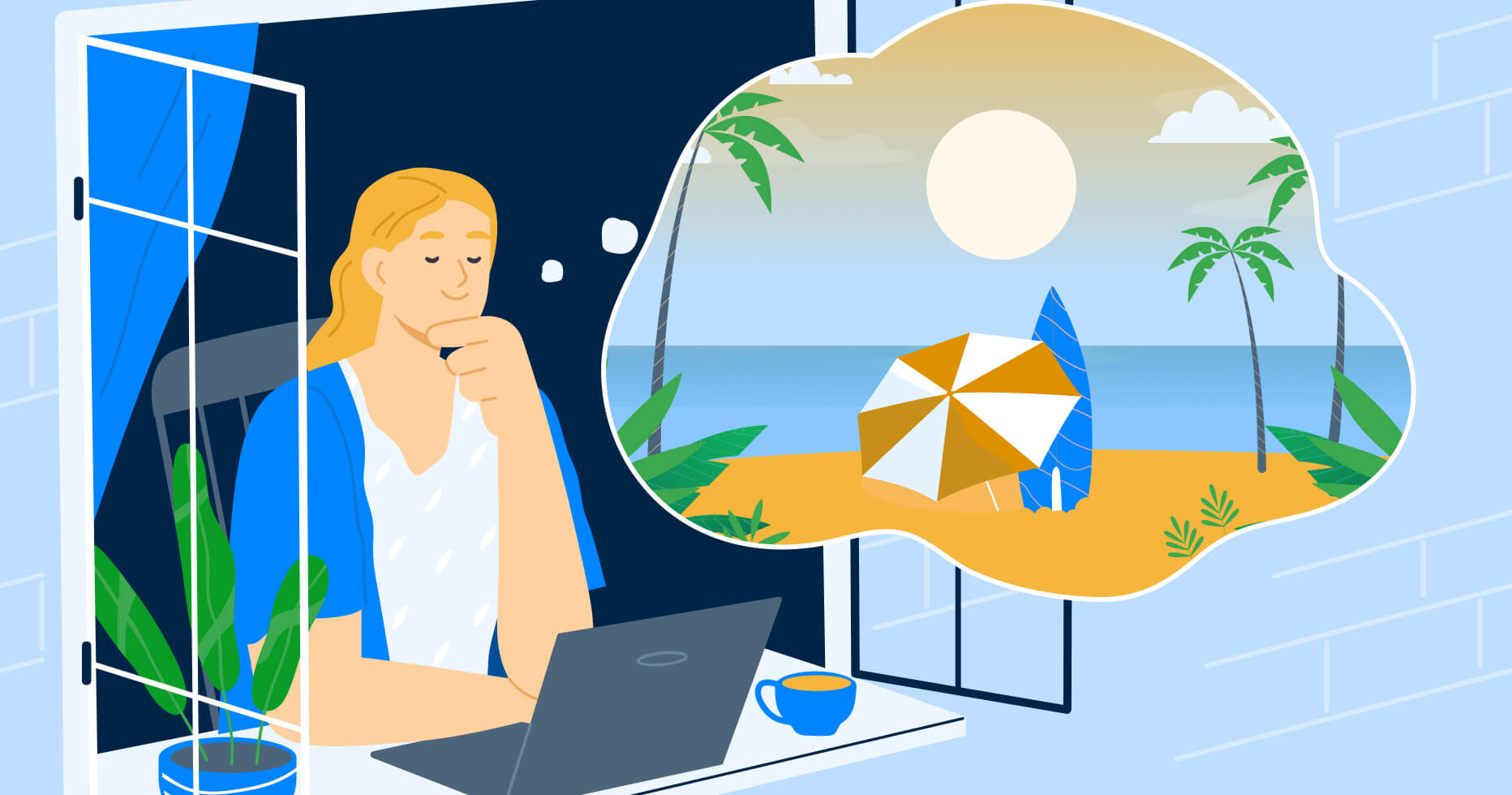To monetize the travel guide using partner links, join the Travelpayouts partnership platform. Here you can find the travel affiliate programs of many popular travel brands, such as Booking.com, TripAdvisor, GetYourGuide, etc.
By promoting travel brands, you help your audience save money on travel and, as a result, travel more. In addition, you can turn your hobby into income. Signing up only takes a couple of minutes and you can start integrating partner link in relevant pages of your guide. You’ll earn every time a user follows your link and purchases a service.
Monetize your project with Travelpayouts, embark on a new journey, and create inspiring content for your audience.
Join the Travelpayouts partnership platform
Join todaybrands
Can You Write a Travel Guide From Home?
Naturally, writing travel guides based on your own experiences and illustrating them with your own photos is much easier and more authentic than writing about a destination you have never visited, although it is not always possible or even necessary to do so. With such a large selection of travel posts on the Internet today, you can easily create a detailed travel blog without ever leaving your home.
In this article, we’ve prepared some travel guide writing tips and a template to help you create useful blog materials. To make your posts even more appealing, explore travel guides created by locals who have a deep knowledge of your selected destination. Of course, be sure to double-check all the information that you share.
Choose a Destination
The first step towards writing a travel guide is selecting a destination. You may choose any location from the world’s most-visited cities, such as New York or Paris, to small idyllic villages. Just remember that your writing will largely depend on this initial choice. As there are already tons of guides about popular destinations, you’ll probably have to find a fresh perspective to make your materials stand out. When it comes to lesser-known spots, it will likely be easier to draw the attention of your audience.
While writing a guidebook, make sure to check with locals who know your destination inside out and can share invaluable advice. Try to connect with them through platforms such as CouchSurfing.org or Facebook.com. Ask them questions or ask them to check over your guide.
Use Travel Guide Structure
While the style of travel guides varies widely, most of them have a similar structure, which consists of tips on transportation, accommodation, tours, activities, popular sites, travel costs, and so on. Make sure to include these sections in your article so that it presents all the information that readers are looking for.
1. How to Get There
Normally, travel guides present several options for getting to each destination, including which cities are nearby, which modes of transportation are available, and the price of those transportation options.
Also, you can offer some tips and tricks on how to plan a trip more efficiently. For example, in some cases, it’s cheaper to take a plane, while, in other cases, ground transportation is a better option. You can also share some money-saving tricks.
2. Accommodations
Today, there are plenty of ways to arrange accommodations in any destination. You can start by suggesting a hotel or hostel via Booking.com, which many tourists are familiar with or have already used. You can then offer to rent places to stay with locals through platforms like Airbnb or HomeAway.
At this point, you can also offer tricks to save money. In some popular locations, such as Barcelona, it is usually cheaper to rent accommodations in the nearest town instead of within the city itself, while, in other destinations, like Paris, choosing the right town while avoiding marginalized areas can be far trickier. Be sure to carefully research the destination and offer valuable advice.
3. Tours and Attractions
After learning about their transportation and accommodation options and costs, tourists will want to explore their destination’s sights and entertainment opportunities. In this section, you can create a list of attractions to visit and excursions that will make sightseeing more exciting. Include options from walking tours to bus excursions to boat trips. For inspiration, look through the Experiences section on Airbnb.com.
4. Getting Around
Another important topic to cover is transportation options within the destination. For example, the first thing travelers would like to know is how to get from the airport/railway/bus station to the city center. There are usually dozens of transportation methods and the price differences between them can be massive, so your readers will appreciate such advice.
It is also important to describe different methods of getting from the transportation hubs to the main attractions while offering options to save a few bucks. In this section, it might be a great idea to ask locals to share tricks. For example, in Lisbon, taxis are often the same price as public transportation or lower.
5. Travel Costs
This is one of the most important parts of any travel guide, as travel costs greatly influence booking intent. Thus, you should briefly cover the prices of flight tickets, accommodations, tours, food and drink options, public transport insurance, and other relevant travel products. Also, for budget travelers, provide tips on how to save money or find the best value.
6. Staying Safe
In this section, you can cover concerns that tourists might have about security. Different cities and areas have different regulations and concerns, so make sure to do the proper research and possibly even ask locals for advice.
So, which questions and concerns should you cover? Consider topics like: where to park a car or exchange money, what areas are best to avoid, are there many pickpockets, and so on.
7. Best Time to Visit
Each destination offers different experiences to travelers at different times of the year. For example, Japan is famous for its cherry blossoms, so it’s worth mentioning the best time to catch them in bloom. European destinations are especially beautiful during the winter holidays thanks to their abundance of Christmas markets and celebrations.
You can recommend the best season to visit each place or offer specific advice for different times of the year.
8. Food and Drinks
In this section, you can describe features of the local cuisine and recommend popular dishes. Then, suggest specific restaurants, markets, or shops with high ratings and positive reviews. To get inspired, check Google Maps, TripAdvisor, or Instagram.
It’s worth mentioning food markets, as they usually have local treats and a wide variety of products at low prices, such as La Boqueria in Barcelona.
How to Write a Travel Guide: Best Practices
Below, you’ll find the best practices for travel writing that will help you make your guides appealing, valuable, and easy to monetize.
1. Add Pictures
Using schemes or images for travel guides is beneficial for many reasons. Posts with pictures receive over 90% more views than ones with plain text. Images help break posts into small parts and make them easier to digest. Readers retain more information and remain interested for a longer time if the text is paired with an image. In addition, 90% of the information that the brain receives is from visual cues.
Thus, make sure to illustrate your post with a few appealing photos to help the audience get inspired. You can also add maps or schemes so that readers can better navigate in the destination, as well as other image types to make the content more illustrative and versatile.
Where to find photos? You can buy photos at photo banks or download free stock images. Moreover, if you stumble upon a nice picture on social media, consider contacting its owner and ask for permission to use it on your site. Another option is to download a stock photo and edit it with one of the free design apps to make it look original. In any case, try choosing only high-quality, unique photos to make your blog look professional.
2. Research Keywords
Keywords are important in terms of website promotion. If you want to drive more traffic from search engines, be sure to run keyword research for your niche. To automate the process, try dedicated tools like Google Keyword Planner and Keywordtool.io (free tools) or SEMrush and Ahrefs (paid programs).
Then, it’s equally important to use keywords properly. That is, find the best placement within the text so that they attract attention and help navigate the text. Also, follow keyword density best practices so that your post doesn’t look spammy. And try to use keyword variations to enrich the text and drive more traffic.
Keywords differ widely: they can be short-tail or long-tail, short-term or long-term, high volume or low volume, geo-targeting, LSI, and more. Some keywords have higher competition, such as short-tail, high-volume keywords, thus aspiring bloggers might find it extremely difficult to compete with established sites. You can start with long-tail keywords and then work your way through the other types as you go.
More practical tips about SEO, including finding and using keywords, can be found in the free SEO course from Travelpayouts and Sharon Gourlay. Watch one lesson from the “Boost Travel Affiliate Revenue Using SEO” course to find out how many keywords you should use in your articles and how to search for them easily and quickly.
All Travelpayouts Academy courses are free for everyone. So feel free to view all the lessons that will help you increase your income.
3. Place Affiliate Tools
When writing a travel guide, don’t forget to insert an affiliate link, widget, banner, or other tools. This can help you monetize your guide and increase your ranking in the SERPs.
The most important thing is to add only relevant tools. For example, when describing sights, add a link to a tours and activities platform, such as Expedia or Musement, so that readers can book an excursion immediately. In the accommodations section, you can link to Booking.com, HomeAway, etc. Such an approach helps your readers easily find a solution to their problem or an answer to their question while generating additional income for you.
We recently published a more detailed guide on using affiliate links on our blog.
Join the Travelpayouts partnership platform
Join todaybrands
4. Choose the Right Format
There are plenty of formats available for travel guides. You can choose to make a post on your blog, a PDF guide, an eBook, and the list goes on.
If you plan on writing multiple guides for your blog, it makes sense to create a separate section and publish all the guides there. You can also create subsections for each country to facilitate better navigation.
To get more leads, you can even create city guides in PDF format and offer to send them for free in exchange for a users’ email address. This could help you grow the number of your subscribers.
If you are writing a travel guide covering multiple destinations, consider adding a table of contents so that readers can easily navigate.
Travel Guide Examples
It might be a good idea to find inspiration before you start writing. Check out a few travel blogs and if you like the structure, perspective, etc., why not adopt those elements for your blog and audience?
Here are a few good travel blogs to check out:
How to Create Online Travel Guides
You don’t need extensive travel experience to create your own travel guidebook or series of travel posts. Start by choosing a destination that will be interesting to your audience, think about the structure of your guide and the various aspects of travel, and perhaps ask locals for additional tips. Also, don’t forget to choose the right format, fill your text with keywords to reach a larger audience, and insert affiliate tools to start earning money immediately.




